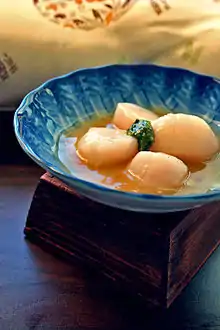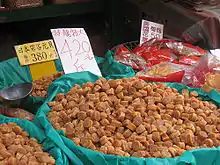Conpoy
Conpoy or dried scallop is a type of Cantonese dried seafood product made from the adductor muscle of scallops.[1] The smell of conpoy is marine, pungent, and reminiscent of certain salt-cured meats. Its taste is rich in umami due to its high content of various free amino acids, such as glycine, alanine, and glutamic acid. It is also rich in nucleic acids such as inosinic acid, amino acid byproducts such as taurine, and minerals, such as calcium and zinc.
| Conpoy | |||||||||||||
|---|---|---|---|---|---|---|---|---|---|---|---|---|---|
 | |||||||||||||
| Traditional Chinese | 江瑤柱 | ||||||||||||
| Simplified Chinese | 江瑶柱 | ||||||||||||
| Literal meaning | river scallop | ||||||||||||
| |||||||||||||
| Alternative Chinese name | |||||||||||||
| Traditional Chinese | 乾瑤柱 | ||||||||||||
| Simplified Chinese | 干瑶柱 | ||||||||||||
| Literal meaning | dried scallop | ||||||||||||
| |||||||||||||
Conpoy is produced by cooking raw scallops and then drying them.
Terminology
Conpoy is a loanword from the Cantonese pronunciation of 乾貝, (Cantonese Yale: gōnbui; pinyin: gānbèi), which literally means "dried shell(fish)".
Usage

In Hong Kong, conpoy from two types of scallops are common. Conpoy made from Atrina pectinata or Gongyiu (江珧) from mainland China is small and milder in taste. Patinopecten yessoensis or Sinbui (扇貝), a sea scallop imported from Japan (hotategai, 帆立貝 in Japanese), produces a conpoy that is stronger and richer in taste .
As with many dried foods, conpoy was originally made as a way to preserve seafood in times of excess.[2] In more recent times its use in cuisine has been elevated to gourmet status. Conpoy has a strong and distinctive flavor that can be easily identified when used in rice congee, stir fries, stews, and sauces.
XO sauce, a seasoning used for frying vegetables or seafoods in Cantonese cuisine, contains significant quantities of conpoy. For example, the Lee Kum Kee formulation lists conpoy as the third ingredient on its label.
See also
- Budu – Fish sauce originating from east coast of Peninsular Malaysia
- Dried shrimp
- Fish sauce – Condiment made from fish
- List of delicacies – Food item that is considered highly desirable in certain cultures
- List of dried foods – Wikipedia list article
- Padaek – A traditional Lao condiment made from pickled or fermented fish that has been cured
- Saeu-jeot – Salted and fermented small shrimp in Korean cuisine
- Shrimp paste – A fermented condiment commonly used in Southeast Asian, Northeastern South Asian and Southern Chinese cuisines
- Smoked scallop
References
- Simonds, Nina (2005). Food of China. Murdoch Books. p. 289. ISBN 978-1-74045-463-6.
- Tsai, Ming; Boehm, Arthur (1999). Blue Ginger: East Meets West Cooking with Ming Tsai. Clarkson Potter. p. 7. ISBN 978-0-609-60530-1.